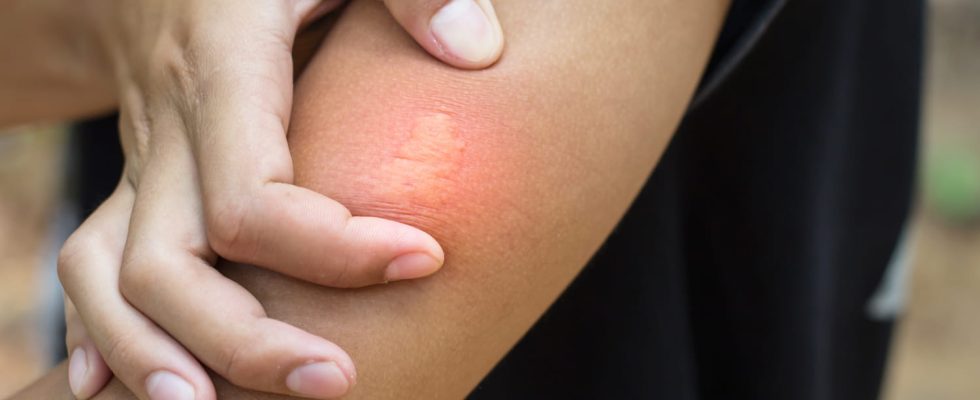Most often mild, a wasp sting is associated with severe pain. How to relieve it? What to take in case of allergy? An antihistamine?
The wasp sting is feared because it is painful. Once the wasp has stung, you have to react quickly and well. We do not put anything on this type of bite. My advice from a pharmacist:
1. Disinfect the bitten area with soap
In the event of a wasp sting, the affected area should be cleaned with soapy water then disinfected with a chlorhexidine-based antiseptic. Disinfection is essential since it eliminates any germs brought by the wasp’s stinger. Unlike bees, wasps do not leave their stinger in the skin during a bite. There is therefore no stinger to remove.
2. Put cold on the bite
After a wasp sting, a sharp pain is immediately felt. To relieve it effectively, you can apply a cold pack or an ice pack. Be careful if you use ice cubes, place them in a cloth and not in direct contact skin as it may cause a burn.
3. Apply cortisone cream if it swells
To limit swelling and the extent of redness, you can apply cortisone cream (Onctose Hydrocortisone®, CortiSédermyl®, CortApaisyl®) in a thin layer with a light massage to facilitate absorption. Onctose Hydrocortisone® cream also contains an antihistamine and an anesthetic, it is preferred in case of pain and itching. If the pain is severe, it is also possible to pour 1 to 2 drops of pure spike lavender essential oil to renew 2 to 3 times in the 30 minutes which follow. This use is to be avoided in children under 7 years of age and pregnant women.
4. Take a painkiller if it hurts
If you feel persistent pain after several minutes, you can relieve it by taking paracetamol, to be renewed after 6 hours if necessary.
5. Take an antihistamine if it itches a lot
If the itching is severe and unpleasant, an oral antihistamine (cetirizine, loratadine) can be administered as one tablet per day. This medicine is available in pharmacies without a prescription.
6. Check your tetanus vaccine
Following a wasp sting, you must ensure your tetanus vaccination status is up to date since it is a skin rash. If you are not up to date with your vaccinations or if you have any doubts, talk to your doctor or pharmacist as soon as possible, who will tell you, if necessary, what to do.
7. Inject a dose of adrenaline and call 15 in case of severe allergy
During a wasp sting, more or less serious signs of allergy may appear. Symptoms such as an swelling of the lips, tongue, throat, difficulty breathing, low blood pressure, discomfort should raise suspicion of anaphylactic shock. In this case, a dose of adrenaline must be administered urgently at the level of the antero-lateral aspect of the thigh using a pre-filled pen. Moreover, you must quickly contact 15 (Samu). If the person stung loses consciousness, the injection must be performed by a third party. In case of known allergy to wasp venom, it is strongly recommended to have your first aid kit at hand. It generally includes a self-injectable adrenaline pen and an Aspivenin® pump allowing the extraction of the venom.
8. Diarrhea, vomiting, drop in blood pressure: consult urgently
A wasp sting is usually harmless. However, if the wasp is swallowed or if the sting is located inside the mouth, throat or at eye level, a medical consultation is necessary. Likewise, if symptoms such as diarrhea, vomiting, severe fatigue or hypotension occur. Besides if 24 hours after the bite, the skin is still very red, swollen and painful, it is necessary to consult a doctor to benefit from an adapted treatment. In fact, it may bean infection to be treated with an antibiotic.
